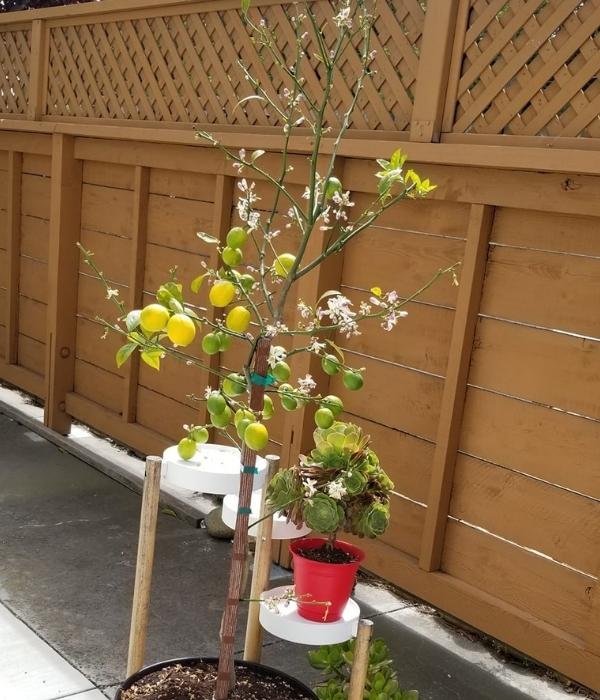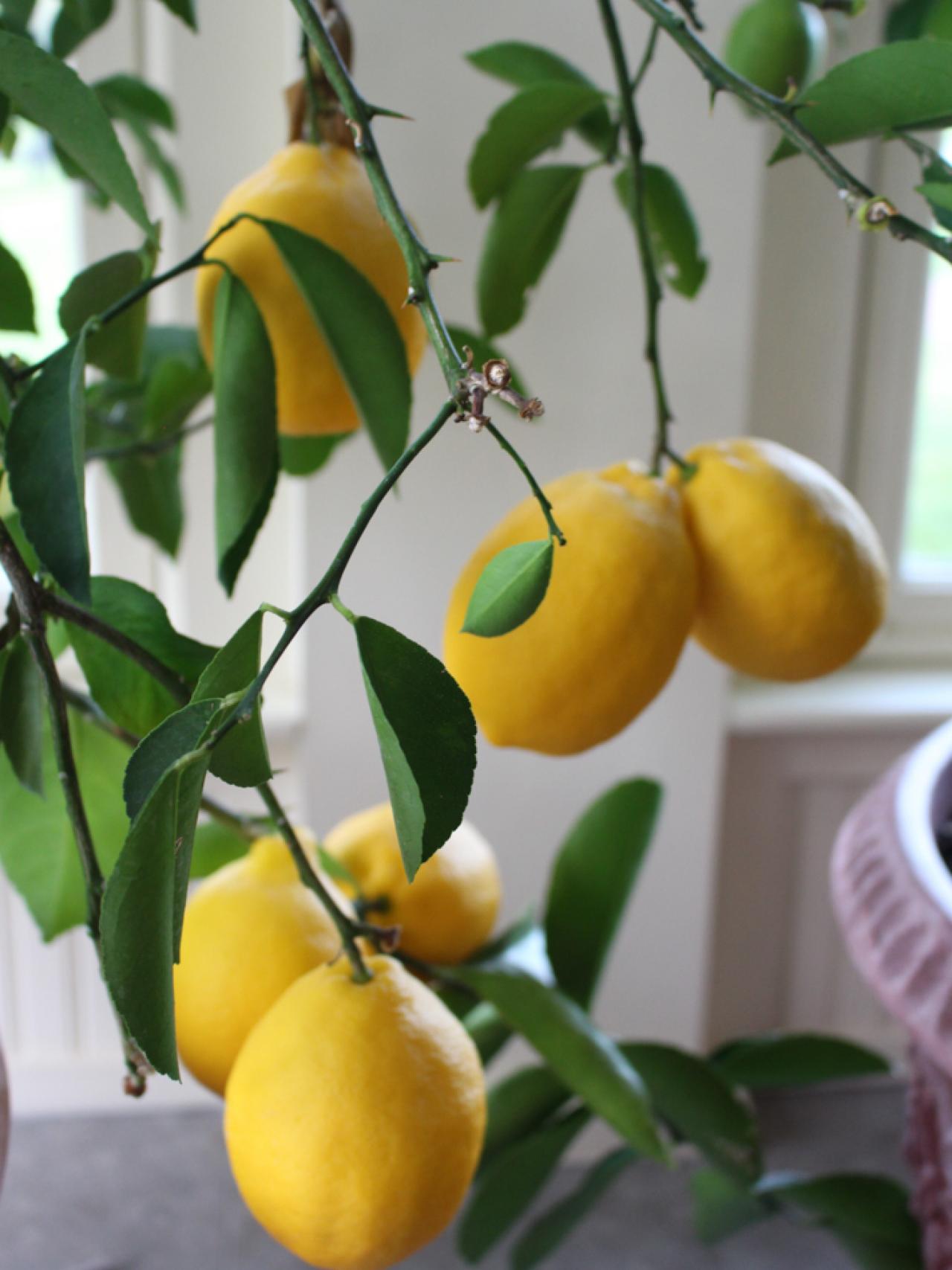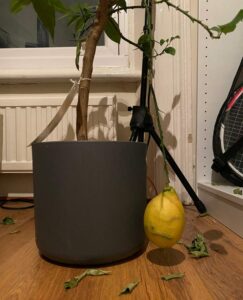Lemon trees lose their leaves when they are overwatered, insufficient sunlight, excessive wind, or when the temperature is constantly below 50 degrees Fahrenheit. Lemon trees transferred indoors from the outside suffer from transplant shock, which results from a difference in humidity, temperature, sunlight, and watering frequency.
Due to a change in their growing environment, lemon trees both indoors and outdoors typically lose their leaves as a symptom of stress.
Continue reading to find out the causes of your lemon tree’s leaf loss and how to put the answers into practice to prevent leaf drop.
Table of Contents
Lemon Trees Can Lose leaves when Temperatures are Below 10°C (50°F)
Lemon trees can be kept outside all year if the winters are mild, as they are native to warmer areas.
Lemon trees must be brought inside when the nighttime temperature is 50° F (10° C) or below since they cannot withstand cold temperatures or frost and may lose their leaves or perhaps perish.
Be especially cautious with little, younger plants as they are more susceptible to leaf drop due to the cold. Citrus trees of all varieties tend to become more robust to chilly weather as they age.
While certain cultivars of lemon trees are more hardy than others, all need protection from frost throughout the winter. Bring them indoors and position them in a sunny window or, even better, a heated greenhouse so they can still take advantage of the longer Winter days’ natural light.
Bring the lemon tree indoors and place it in a sunny window right away if it is starting to lose leaves as Winter approaches. This will help to reduce further leaf loss and prevent frost damage, allowing the lemon tree to recover in the Spring when it is warmer outside and there are more hours of daylight.
However, it should be mentioned that if you do not adhere to the proper best practices of maintenance, bringing a lemon tree indoors could result in more leaves falling.
Indoor Lemon Tree Losing its Leaves
If you recently purchased a lemon tree from a garden center or brought your lemon tree indoors to protect it from lower temperatures in the Winter, the lemon tree frequently loses some, if not all, of its leaves as a result of the shock of the contrast in conditions between the outdoors and your home.
Before being sold, lemon trees are grown in greenhouses where they have adapted to highly precise conditions, causing them to endure transplant stress when they are placed in a different habitat.
Like all citrus plants, lemon trees are susceptible to unexpected changes in their environment and may lose their leaves for the following reasons:
- Humidity. Compared to the outside or greenhouses, buildings often have substantially lower humidity levels in the winter.
- Sunlight. Because lemon trees are indigenous to warm regions with intense full sun, the indoor environment can be overly shadowed, with fewer daylight hours and lower light levels in the winter.
- Temperature. Lemon trees are not resilient below 50° F (10° C), however if the lemon tree is next to a heat source, the sudden change in temperature from cool outdoors to hot indoors might induce shock and leaf drop.
- For lemon trees to be in the direct air current, forced air or air conditioning is also too dry since it dries out the leaves, causing them to drop to conserve water.
- Lemon trees may become stressed due to the variation in watering frequency, which may result in leaf drop.
(Read my post on how to water lemon trees to discover how to determine the right watering frequency for your climate.) Lemon plants need more water in the summer and less in the winter.
When brought indoors, it is fairly typical for a lemon tree to lose its leaves. Fortunately, this is merely a reaction to the stress of being moved, and there are techniques to lessen the effects of that stress so that your lemon tree survives its initial leaf loss.
How to Revive a Lemon Tree That Lost its Leaves After being Moved
Lemon trees should be revived after losing their leaves in order to prevent further loss.
- Because homes have unusually low humidity levels in the winter, it’s crucial to often mist your lemon tree’s fruit and foliage. When you first bring the tree inside, water it. You should also leave a spray mister near the lemon tree as a reminder to sprinkle it every other day until it is more accustomed to your house. If you find that your tree’s leaves are shriveling, water it more frequently and mist it more often.
- Place the lemon tree in the home’s most sunny window, preferably one that faces south. A heated greenhouse is even preferable. Maintaining high levels of light is essential since a sudden decrease in daylight is one of the main causes of the lemon tree losing leaves.
- If you are growing your lemon tree indoors, try to maintain a relatively constant temperature in the space. Temperature extremes throughout the day and at night can put the leaves under stress and cause them to fall. Keep the lemon tree away from radiators or any other heat source because doing so will cause the soil to evaporate more quickly and cause the pot to dry out. The lemon tree then responds by shedding leaves to help retain moisture during dry spells.
- Avoid forced air and air conditioning currents since they dehydrate the lemon tree’s leaves, causing them to drop. To counteract the dry air caused by artificial air currents in the house, mist the lemon tree.
- You must increase the frequency of watering your lemon tree to prevent leaf loss because higher temperatures, dryer air currents, and reduced humidity all contribute to water loss. This is a delicate balancing act, though, as the lemon tree naturally grows more slowly due to fewer hours of direct sunlight and a reduced light intensity, making it more susceptible to overwatering. When the top two inches of the soil feel dry, water with a good soak. Test the soil occasionally to decide how often is best to water.
Do not be alarmed if your lemon tree is losing leaves; with the proper care, the lemon tree should recover and new leaves should begin to sprout in the early spring when the number of daylight hours and intensity rise.
Place your potted lemon outside or in a greenhouse as soon as the weather warms up and the nights are consistently warmer than 50° F (10° C). This will give it greater exposure to light and prevent it from being stressed by things like air currents and dry indoor air.
When the lemon tree is outside, in a great sunny area, and at a higher temperature, it should really start to perk up.
(Read my article Why are my lemon tree leaves curling for the remedy if your leaves are curling rather than merely dropping off.)
Lemon Trees Drop Leaves due to Over watering
- excess watering
- soils that drain slowly.
- pots without base drainage holes.
- the practice of placing trays under pots to stop water from draining away from the roots.
Lemon trees are native to regions with hot summers, lots of sunshine, and soils that drain quickly.
Lemon trees are hence much more vulnerable to overwatering than underwatering.
The leaves of your lemon tree show signs of stress by becoming yellow, drooping, and dropping off when there is too much water around the roots.
If the leaves on your lemon tree are turning yellow, read this article to learn why and how to save it.
It’s critical to apply excellent methods for watering as soon as you can because if the roots of your lemon tree are sitting in constantly soggy soil or pots, this supports the conditions for the fungus that causes root rot, which more frequently kills the lemon tree.
How to Save an Over Watered Lemon Tree Losing it Leaves
- Reduced watering frequency is one of the most crucial steps. Lemon trees like somewhat dry soil between waterings rather than soil that is always humid since this mimics the circumstances found in their natural environment. Once a week, give lemon trees a good soak so that water drips out the bottom of the pot, or wait until the top two inches of soil are completely dry before watering. The amount of water a lemon tree needs will vary depending on the climate, with arid climates needing more water and humid climates needing a little less. You should thus alter the frequency of your waterings accordingly.
- Lemon plants need soil that drains well. The same effect as overwatering is practically replicated if the soil is too slow to drain, keeping the soil excessively moist for the roots of your lemon tree. A decent potting combination includes a third of multipurpose compost, a third of garden compost, and around a third of grit or perlite for nutrients and to speed up drainage so that the soil can partially dry out in between irrigations. It might not be required to replace the soil if it appears to drain well; instead, you should water the tree less frequently.
- The use of trays or pots without holes at the bottom might result in the soil becoming soggy, which causes the lemon tree to lose its leaves and suffer root rot. Transplant your tree into a container with holes in the bottom to let excess water drain, and regularly empty watering trays.
Find the sunniest spot in your garden for your lemon tree. Lemon trees need full sun, which aids in drying the soil between waterings or after rain.
Because there is less water loss from the leaves in extremely humid climates, less frequent watering is frequently necessary.
Your lemon tree should be less stressed, stop dropping leaves, and grow new leaves in the spring and summer if you reduce watering and follow best practices to let the top two inches of the soil dry out.
Lemon Tree Losing Leaves due to Lack of Water
Even while overwatering is the more frequent cause of leaf loss on lemon trees, a lack of moisture may also be to blame.
Before falling, the leaves should seem withered; this is a sure sign that the lemon tree is under stress from the dryness.
Lemon trees may lose their leaves if there is insufficient moisture as a result of:
- watering insufficiently. While lemon trees prefer to have their leaves watered just occasionally, if they are watered too little, they may experience dryness and leaf drop. The roots of the lemon tree may suffer and the leaves may drop to assist preserve moisture if the tree is watered too sparingly, only moisturizing the soil’s surface. Lemon trees need a deep soak to the point where water drips out the bottom of the pot.
- When a lemon tree is indoors, dry air, strong winds, or dry conditions rob the leaves of moisture, causing the leaves to fall.
- The rate at which the soil dries out and can deprive the lemon tree of moisture, resulting in leaf drop, is accelerated by intense heat in a greenhouse, near to a source of heat, or as a result of meteorological conditions.
Revive Lemon Trees Losing Leaves due to Drought
With some care and attention, lemon trees that have lost leaves due to the drought can be restored.
When there has been a severe drought, it is crucial to wet the root ball as thoroughly as possible.
When soil entirely dries out, it can bake hard and cause water to run off the top and down the edge of the pot instead of getting to the roots where it is needed by lemon trees.
Therefore, it’s crucial to soak the entire pot for a brief period of time, preferably even submerging it.
The moisture can effectively penetrate the soil and the lemon tree can receive the drink it needs to aid in its recovery if you completely submerge the lemon’s pot in a sink or possibly a wheelbarrow full of water for around 10 minutes.
If any leaves are still there, spritz them with a spray bottle to enhance humidity and prevent water loss through the leaves, which should help preserve the foliage.
If there is a heat wave, I advise shielding the lemon tree from the sun during the day so the roots may absorb moisture without being stressed by direct sunlight, which dries out the soil.
After you have given the lemon tree a thorough watering, mist it frequently (a few times each week) and give it a good soak once a week.
On indoor lemon plants, which flourish in the dryer house environment, periodic misting also lowers the risk of spider mites.
As long as the moisture balance is restored with the right watering techniques, this approach gives the lemon tree its best opportunity of recovering from drought, and new leaves should appear over the course of the following few weeks.
To learn how to save a dying lemon tree, read my post.
Lemon Trees Losing Leaves Because of Lack of Sun
If the lemon tree is in the shadow, leaf drop might also happen.
Lemon trees have a unique adaptation that allows them to flourish in full sunlight; however, if they are in shade, the leaves may become yellow and drop off, making the plant appear somewhat sickly.
Whether in the garden, greenhouse, or indoors in the winter, always place your lemon tree as much sun as possible.
When bringing lemon trees inside for winter protection, it is especially crucial to place them in south-facing, sunny windows since the lemon tree needs as much sun as possible to stay healthy and prevent leaf drop. Winter also brings fewer hours of sunlight and a lower light intensity.
Lack Of Fertilizer can Contribute to Leaf Drop
Due to the ideal drainage conditions and the ability to move lemon plants indoors for winter protection in cold locations, lemon trees thrive when grown in containers.
The leaves may become yellow and some may drop off as a result of the roots depleting the nutrients in the pot.
During the growing season, I advise using a particular citrus fertilizer, which is obtainable at garden centers and on Amazon.Fruit should be produced as a result, and the plant will remain healthy and more resilient to cold weather and leaf drop.
Key Takeaways:
- Lemon trees lose their leaves when brought indoors for Winter protection due to a contrast in growing circumstances, cold temperatures, excessive watering, excessive shade, and other factors.
- Lemon trees that are losing leaves need to be protected from the cold, kept humid, and given the right quantity of watering in order to recover.
- When lemon trees are protected from temperatures below 50° F (10°C), irrigated once each week with a generous soak, and misted with water on the surviving leaves, they can renew their leaves.
- Due to a lack of humidity or changing temperatures if they are close to a heat source, indoor lemon trees might lose their leaves in dry homes. Lemon trees can be grown indoors in sunny south-facing windows. Mist the plants frequently, and water them when the top 2 inches of soil get dry. When there is more sunlight in the early spring when new leaves are beginning to develop, the lemon tree frequently recovers.
FAQ
Is Miracle Grow good for lemon trees?
Use on all citrus, palm, and fruit trees.
How do you bring back a dying citrus tree?
You might be able to save your citrus or lemon tree by moving it to a raised bed with full-sun and humus-rich soil if you feel that the plant’s limbs are dying because it is in a shady, marshy location. However, if the plant is already stressed, transplant shock could also be fatal.
What is the best fertilizer for a lemon tree?
6-6-6 is the ideal fertilizer for lemon trees. If necessary, you can use a stronger mixture, but it shouldn’t be more than 8-8-8. A solid alternative for fertilizing lemon trees is the Down to Earth Citrus Mix Fertilizer. Other trees, such apple or pear trees, will not benefit from citrus fertilizer.
Why is my citrus tree dying?
Any citrus dieback, including twig dieback, limb decline, and leaf or fruit drop, can be easily explained by the plant being under stress. A pest invasion, disease outbreak, advanced age, or a drastic environmental change such a drought, flood, or significant root or storm damage could all be the blame.
How do I revive my lemon tree?
Recreate the climate of a dying lemon tree’s natural Mediterranean region by providing full light, wet soil with adequate drainage, wind protection, and specific citrus fertilizer to guarantee the it has the nutrients it needs.



